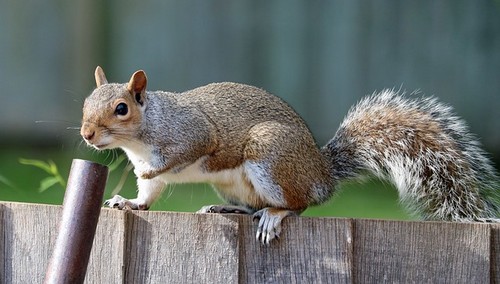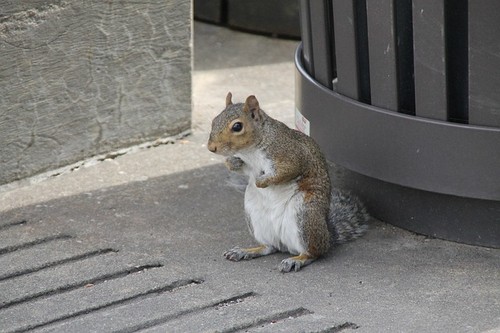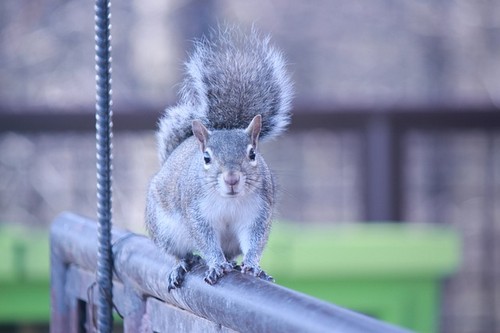How Squirrels can Become Pests and the Risks They Bring
Squirrels are a common sight in England, and can often be spotted in parks or our gardens scurrying around trees. The grey squirrel was originally introduced into England’s ecosystem in the late nineteenth and early twentieth century after they were brought over from America. In the century since the grey squirrel’s arrival in Britain, they have pushed the native UK red squirrel to near extinction.
It can be easy to think of the grey squirrel as a cute and harmless creature, and they are often romanticised as a quintessential part of British wildlife. However, the grey squirrel can be very territorial and once they settle in your home, they can be a danger.
Why a squirrel infestation is a problem
Squirrels are very determined animals, so once they’ve found a way into your home and have built up a nest, it is exceptionally hard to remove them.
Squirrels have ever-growing incisor teeth, so they will need to gnaw to keep their teeth from growing too long, and often the roof timbers in your loft are the perfect place for them to do so. Alternatively, squirrels will chew through water pipes and electric cables which can cause immense damage to your property and could be costly to repair – there have been reported cases of squirrels chewing through wires that have led to fires breaking out, or gnawing on roof joists so much that the floors in the attic have weakened and people have fallen through the ceilings. We’ve also dealt with a case where a family had to leave their home for six months after squirrels had chewed through water pipes in the loft and caused a flood which devastated the house, so don’t underestimate just how much havoc these tiny animals can wreak!
It’s also important to note that once squirrels have found a safe nest, they can get very protective over their territory, especially if they have babies there. The squirrels can get very agitated and aggressive if you inadvertently disturb their nest and can be a danger to anyone approaching their territory.
How squirrels get into your home
Squirrels will take advantage of any existing gaps in your property, such as unscreened vents or developing holes. They commonly use their teeth to gnaw through soffits and fascia boards to enter the loft, and they can gnaw through window frames or lead rain flashing to enter the property. Squirrels can enter a property at ground level but more often enter at a higher level. They can scale a vertical wall to the roof level, but more often use nearby trees or wires to get onto the roof and then enter your building via the chimney or roof tiles.
Signs of an infestation
If you suspect an infestation on your premises, there are a number of signs, aside from an actual sighting of an infestation, that you should look for that will indicate the presence of squirrels. Squirrels will normally nest in the attic of your property, so this is the area of your property that you should check. Signs include:
- Loud noises in the loft are the most common indication of squirrels. Squirrels are relatively heavy animals and are very active. The noises are often accompanied by loud banging and thumping sounds as the squirrels bound around the loft, and are often heard during daylight hours as well as at night.
- The loft insulation is usually tufted in the areas where they are active, caused by their claws as they run over it.
- Large areas of insulation are sometimes missing where the squirrels have taken it for a nesting material.
- The nests are sometimes visible in the loft and usually appear as a heap of insulation in the corner or at the edge of the loft. These should not be approached or disrupted in case of aggravating the adult squirrels.
- Damage to the equipment stored in the left is common, particularly to cardboard boxes which they strip for nesting materials.
- Look for gnaw marks on wood, cables or pipes in your property.
- Droppings are typically brown, cylindrical and approximately 8mm in length.
- Footprints and scratch marks are commonly seen in dust.
Treating an infestation
Once you have identified a squirrel infestation at your property, you will need to take steps to treat the problem as soon as possible. It can be tempting to simply attempt to scare the squirrels away and once they have left the property, board up the hole they were using for access; we would not recommend this. As we’ve mentioned, squirrels are very territorial and can respond with aggression, especially if they become separated from their young. There have been cases of squirrels throwing themselves at walls and attacking any possible entry point to get back to their nest and their young, so evoking this response should most definitely be avoided.
It is imperative that you do not attempt to release grey squirrels back into the wild if they are caught in your home. To do so is illegal under Schedules 5 and 6 of the Wildlife & Countryside Act 1981. This is because of the risk they cause to the endangered red squirrel and other fauna and wildlife. If you catch a squirrel in your home, you are obliged to humanely dispatch it under law.
The best way to treat a squirrel infestation is to call in a professional service who will use spring-activated traps or live traps to eradicate all squirrels currently on-site. Ideally, any gaps that allowed the squirrels n to gain entry to your property should be sealed to avoid a repeat infestation.
To tackle your pest problem quickly and make your property safe and habitable again, our same-day response service guarantees complete eradication. To help you keep your property pest free, our team of experts can also offer you prevention methods to help you avoid a repeat infestation.
Pest Defence can offer you high quality, quick and effective pest removals throughout Essex, London and all of the surrounding areas – simply get in contact today to find out whether we serve your area directly.



